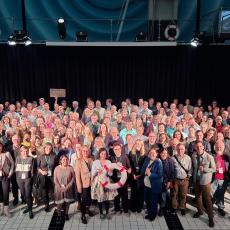In a country where people are called to the ballot box several times a year, citizens are sometimes confronted with complex issues. To help them understand what is at stake, governments like in Switzerland sends out a booklet presenting the arguments for and against the question being put to the vote. A manual to the manual by Alexander Thoele.
In Switzerland, the "explanations by the cabinet" are sent to all citizens´ homes at least three weeks before a vote takes place. This is a standard procedure laid down by law, which is repeated before each nationwide vote. The publication - which has one of the largest print runs in the country - is produced by the federal administration, and seeks to explain what the referendum or initiative is about in straightforward, easily comprehensible language.
"We want everyone to be able to understand the question, even if they are not familiar with the subject," explains Thomas Abegglen, who was in charge of bringing out the booklet at the Federal Chancellery for over ten years.
Official document
The explanatory booklet is the size of an A4 paper folded in half. The cover page is red and resembles a Swiss passport, with the text in white characters and the flag of Switzerland at the bottom. "This is to show that it’s an official document,"says Abegglen. The number of pages varies according to the number of issues being put to the vote, but the structure does not change.
For each issue, the reader finds first the question to be decided on and the voting recommendation of the government and parliament, then a summary of the main points followed by a more detailed explanation, then the actual text being put to the vote, and lastly the arguments of the opposing party and the cabinet. This formal structure stems from legal requirements.
"The government has a constitutional obligation to give the voters its opinion as well as explanations about the matter being voted on," says the former coordinator, who worked as a political journalist and parliamentary correspondent before joining the chancellery. He emphasizes that the strict rules applied in drawing up the booklet prevent any manipulation of public opinion.
"The booklet presents not only the government’s viewpoint but also that of the initiative or referendum committees, which are moreover free to communicate their positions in other ways, for instance through posters or street campaigns," he adds.
This effort to inform voters has been going on for decades. The first booklet was produced in 1977, after earlier challenges to explain the content of a complex Free Trade Agreement with the European Communities. Today’s voters could hardly manage without it. According to opinion polls conducted by Vox Institute, the attention rate is 90% for complex topics and 60% for widely discussed topics.
Neutrality and accuracy
The issues being put to the vote are sometimes highly controversial, such as the ban on building minarets in 2009. Although most topics are not so sensitive, the booklet’s authors strive to maintain a neutral tone and stance whatever the subject. "Many different departments in the federal administration are involved in the complex production process,"says Abegglen.
Work begins six months before a vote is due to take place. To start with, representatives of the ministry concerned by the issue are invited to write draft texts.
Europe: Passport to Active Citizenship
Trying to change the education system? Having a problem with poisoned food products? Want to move the lorries from road to rail? Or having problems registering your company across the border? EU citizens have many rights and face hard choices - but they need to know what options they have to influence issues and in which arenas. For this reason, the European Economic and Social Committee has published a new manual to active citizenship in 22 languages, written by people2power.info-editor-in-chief Bruno Kaufmann. The new European democracy passport includes a detailed manual on the European Citizens Initiative (ECI). More than 50 ECIs have been filed since 2012, including the successful proposals to prevent water privatisation and initiatives to develop a pan-European education system, provide more support to Greece and setting a speed of 30 km/h in towns across Europe. democracypassport.eu
These proposals are then discussed at three meetings attended by government representatives and communication specialists from the different ministries, the chancellery and translation departments. The challenge is to provide clear and succinct answers to all questions that the citizens might have, regardless of their level of education or knowledge. "At these meetings, we often play the role of the citizen by questioning the experts and trying to find a way of expressing things as clearly as possible," explains Abegglen.
Much attention is also paid to the accuracy of the information that is to be published. "Everything, including the figures and graphs, must be checked and double-checked," says the former coordinator. The final version is submitted directly to the minister responsible, who can request changes to the wording. The definitive version is then approved by the entire cabinet.
Low cost per unit
After approval, the texts are sent for printing. According to official data from the chancellery, the production cost of 5.4 million booklets is CHF507,000 ($505,000), which corresponds to 9.4 centimes per unit. As for the cost of the paper, transport and recycling, and the possibility of no longer actually printing the booklet, the former coordinator cites legal considerations. "It is not under discussion, because the booklet is already available in electronic form. But we are obliged by law to provide this tool to all citizens, even those who don´t have a computer at home or who refuse to form their political opinions sitting in front of a screen," he asserts.
People with physical disabilities also have access to the information. The electronic version is available in an adapted form. Private providers also offer additional information materials based on the content of the booklet.
"The booklets are read into a microphone and recorded so that they can be distributed to the blind. There are also versions published in large characters, for easier reading," says Abegglen.
In the internet age, the authorities are discussing ways of modernising the language used in the booklets, but they come up against legal barriers. "The matter is being discussed, but the law does not give us much leeway: it stipulates the publication of these recommendations in a very precise form," says Abegglen. But he does not exclude the use of technology in the web version of the booklet. "We have already started to include videos, simple graphics and additional texts for specific audiences such as young people."
Mistakes
Despite all the care and effort, mistakes do sometimes pass undetected. In 2011, the Federal Court judges criticised the booklet on the vote on a corporate tax reform, deeming it "incomplete" and "incorrect." Two years later, the booklet ascribed to pharmaceutical companies a position that they did not have in the debate on the reform of the epidemics law. And in 2014, the text of an initiative by environmentalists, aimed at restricting immigration, was translated inaccurately into French. In all such cases, chancellery immediately corrects the texts, even if it is not possible to reprint the booklets. "If this happens, we issue a public statement and make the corrections in the online version," says Abegglen, who knows about no similar effort worldwide to continuously inform voters.
This piece has been written by Alexander Thoele from our hosting media partner swissinfo.ch, where this piece was published first in Portuguese. Julia Bassam has translated it into english. The article is also available in Japanese. (Photo courtesy: Swiss Federal Chancellery)


